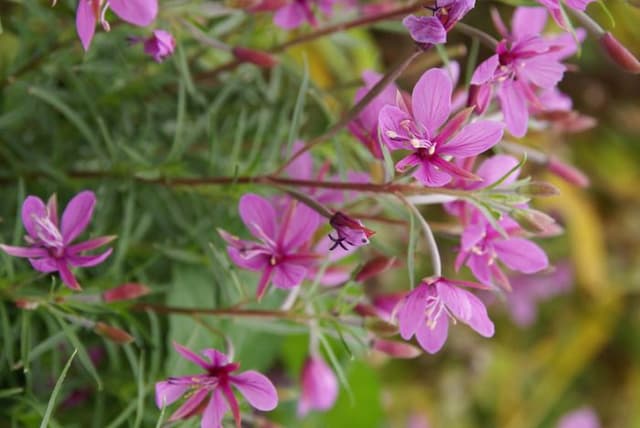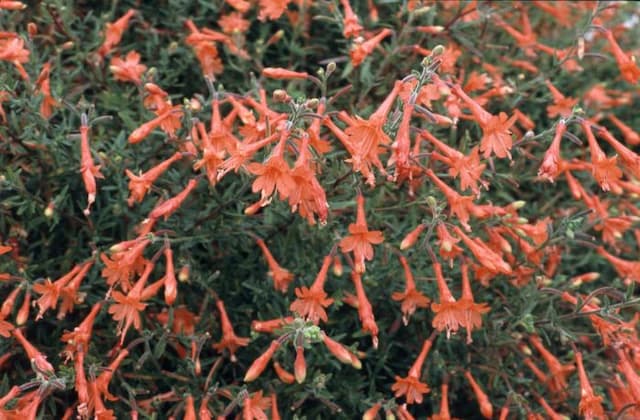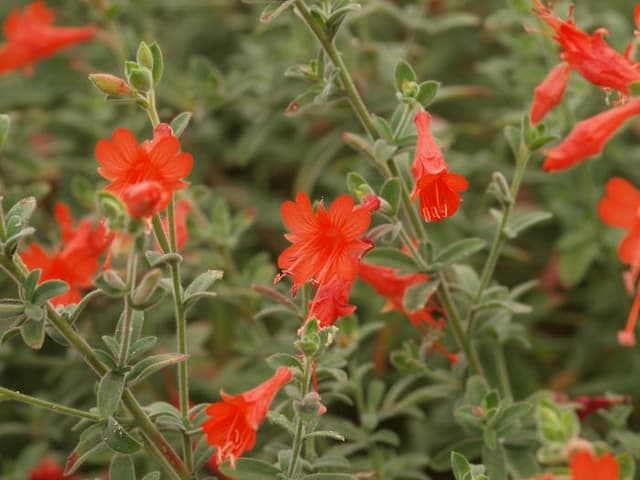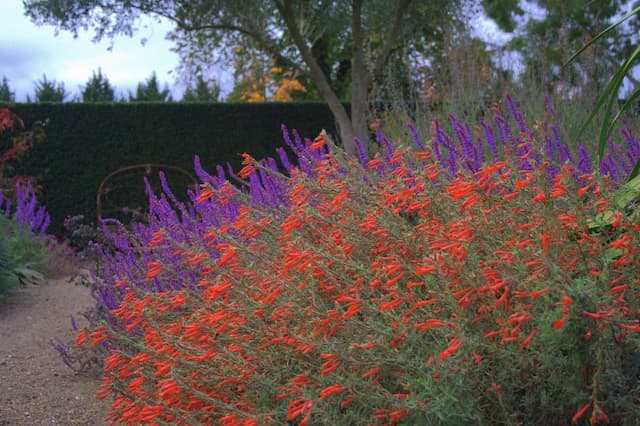Tree Fuchsia Fuchsia arborescens

ABOUT
Fuchsia arborescens, commonly known as the tree fuchsia, is noted for its distinctive and ornamental appearance. The tree fuchsia boasts a profusion of delicate, pendant-shaped flowers that are typically a vibrant pink to purple in color, often with elongated, tear-drop petals and prominent, protruding stamens that add to their decorative look. The blooms, which are known to attract hummingbirds, cluster together in graceful bunches, creating an enchanting, cascading effect that is particularly striking when the plant is in full bloom. The foliage of the tree fuchsia consists of soft, green leaves that have a slight sheen and are arranged in a bushy formation. The leaves are oval to elliptical in shape with a pointed tip and subtly serrated edges, contributing a lush, verdant backdrop that highlights the vivid colors of the flowers. As seasons change, the tree fuchsia may also produce small, edible, dark-purple fruits that are oval in shape, adding an additional layer of visual interest to this attractive plant. Widely admired for its showy flowers and year-round appeal, the tree fuchsia makes a lovely addition to gardens and indoor spaces where its ornamental qualities can be fully appreciated, disregarding its specific dimensions.
About this plant
 Names
NamesFamily
Onagraceae
Synonyms
Lilac Fuchsia, Tree Fuchsia
Common names
Ellopsis eburnea, Fuchsia cordifolia, Fuchsia sanguinea, Fuchsia splendens, Fuchsia tenera
 Toxicity
ToxicityTo humans
Fuchsia arborescens, commonly known as the tree fuchsia, is not listed as a toxic plant to humans. There are no well-documented cases of poisoning or toxicity resulting from ingesting parts of this plant. Therefore, to the best of current knowledge, consumption of the tree fuchsia does not pose a threat to human health, and there are no expected symptoms of poisoning.
To pets
The tree fuchsia is not known to be toxic to pets. There is no significant evidence suggesting that the ingestion of parts of Fuchsia arborescens causes toxicity in animals such as dogs and cats. Consequently, it is considered safe in terms of not causing symptoms of poisoning to pets under normal circumstances. However, it is always advisable to prevent pets from eating plants as a general precaution, and to consult with a veterinarian if an animal does ingest plant material and shows signs of distress.
 Characteristics
CharacteristicsLife cycle
Perennials
Foliage type
Evergreen
Color of leaves
Green
Flower color
Pink
Height
10 feet (3 meters)
Spread
6 feet (1.8 meters)
Plant type
Tree
Hardiness zones
9
Native area
Mexico
Benefits
 General Benefits
General Benefits- Ornamental Value: Fuchsia arborescens, commonly known as the tree fuchsia, is prized for its attractive flowers and can be used to enhance garden aesthetics.
- Habitat for Wildlife: The tree fuchsia provides nectar for pollinators such as bees and hummingbirds, supporting local ecosystems.
- Shade and Shelter: As a larger shrub or small tree, it can offer shade and shelter for smaller plants and animals within a garden setting.
- Long Blooming Period: Tree fuchsia has a long flowering season which ensures a continuous and vibrant display in the landscape.
- Ease of Propagation: The plant can be easily propagated from cuttings, making it a cost-effective option for gardeners to expand their plant collection.
- Adaptability: Fuchsia arborescens is known to adapt well to various growing conditions, which makes it suitable for a variety of garden environments.
 Medical Properties
Medical Properties- Anti-inflammatory: Used to reduce inflammation.
- Analgesic: Employed for its pain-relieving properties.
 Air-purifying Qualities
Air-purifying QualitiesThis plant is not specifically known for air purifying qualities.
 Other Uses
Other Uses- Hummingbird Attractant: Fuchsia arborescens is often used in gardens to attract hummingbirds due to its bright, tubular flowers that provide an excellent source of nectar for these pollinators.
- Bonsai: Some enthusiasts use Fuchsia arborescens for creating bonsai due to its attractive flowers and the tree-like form the plant can take when pruned and trained properly.
- Shade Tolerance: This plant can be used in shaded areas of gardens where other flowering plants might not thrive, thus providing color and life in darker garden spots.
- Living Fences: When grown closely together, Fuchsia arborescens can form a natural and colorful living fence, offering both privacy and beauty.
- Educational Tool: In botanical gardens and educational programs, Fuchsia arborescens is used to teach plant biology and the importance of protecting native species and their pollinators.
- Cultural Significance: It may be included in gardens for cultural or historical reasons, representing specific traditions or local horticulture where fuchsia species are native.
- Photography Subject: The striking appearance of Fuchsia arborescens flowers makes them a popular subject for photographers and artists, especially when capturing garden biodiversity.
- Scented Gardens: Though not known for a strong fragrance, the subtle scent of its flowers can contribute to an aromatic garden that focuses on engaging multiple senses.
- Floral Arrangements: The long-lasting flowers are sometimes used in floral arrangements and bouquets to add a splash of color and unique texture.
- Erosion Control: Because of its ability to spread and its woody stems, it can be used to stabilize sloping ground in gardens, thereby helping to prevent soil erosion.
Interesting Facts
 Feng Shui
Feng ShuiThe Fuchsia is not used in Feng Shui practice.
 Zodiac Sign Compitability
Zodiac Sign CompitabilityThe Fuchsia is not used in astrology practice.
 Plant Symbolism
Plant Symbolism- Confidence - Fuchsia arborescens, with its elegant blossoms, is often associated with confidence due to its bold and striking appearance.
- Elegance - The delicate teardrop shape of the flowers symbolizes elegance and grace.
- Good Taste - Often found in ornamental gardens, the fuchsia is considered a symbol of good taste and sophistication.
- Achievement of Personal Goals - Flourishing in a variety of conditions, the fuchsia plant is symbolic of personal growth and achievement of goals.
 Water
WaterThe Tree Fuchsia should be watered when the top inch of soil feels dry to the touch. This typically means watering thoroughly once or twice a week, allowing excess water to drain away to prevent root rot. They prefer consistent moisture, so during hotter spells or in more arid climates, you may need to water more frequently. Aim for about 1 gallon of water per week, adjusting as needed for your climate and the plant's current growth stage.
 Light
LightThe Tree Fuchsia thrives in partial shade to moderate light conditions. It is best placed in a spot that receives bright, indirect light with protection from the harsh afternoon sun, which can scorch its leaves. An east or north-facing window or a shaded area in a southern room is ideal for this plant.
 Temperature
TemperatureThe Tree Fuchsia prefers moderate temperatures and can survive in a temperature range from 40 to 80°F. Ideal growing conditions are between 60 to 70°F during the day and slightly cooler at night. It is sensitive to extreme cold and should be protected from temperatures below 40°F to prevent damage.
 Pruning
PruningThe Tree Fuchsia should be pruned to maintain its shape and remove any dead or diseased wood. Pruning is best done in the late winter or early spring before new growth starts. This rejuvenates the plant and encourages bushier growth and more flowers. Prune no more than one-third of the older stems to keep the plant healthy and productive.
 Cleaning
CleaningAs needed
 Soil
SoilFor the best growth of the Lilac fuchsia, a well-draining soil mix is essential. A combination of one part peat, one part loam, and one part perlite or pine bark works well. The ideal soil pH should be between 6 and 7 for optimal plant health.
 Repotting
RepottingLilac fuchsia should be repotted every two to three years or when the plant has outgrown its current pot. Springtime is the best period for repotting to encourage new growth in the coming season.
 Humidity & Misting
Humidity & MistingLilac fuchsia thrives in moderate to high humidity conditions. The ideal humidity level for this plant ranges from 60% to 70%.
 Suitable locations
Suitable locationsIndoor
Place Lilac fuchsia in bright, indirect light and keep soil moist.
Outdoor
Grow Lilac fuchsia in semi-shade, shelter from strong winds.
Hardiness zone
9-11 USDA
 Life cycle
Life cycleFuchsia arborescens, commonly known as the Lilac Fuchsia or Tree Fuchsia, begins its life cycle as a seed which, when sown in fertile, well-draining soil and under adequate conditions of moisture and warmth, germinates to produce a small seedling. The seedling grows into a young plant by developing a root system and foliage; during this growth phase, it requires regular watering and protection from extreme weather conditions. As the plant matures, it develops a woody stem and branches, entering its vegetative stage characterized by substantial leaf growth. Lilac Fuchsia then enters the flowering stage, producing clusters of pendulous, tubular flowers typically mauve to purple in color which attract pollinators; successful pollination leads to the formation of berry-like fruits that contain numerous seeds. After seed dispersal, which may occur through animal ingestion or simple drop to the ground, the parent plant continues to grow and can produce flowers and fruits multiple times within its lifespan, often for several years. Over time, older individuals may eventually decline in vigor, leading to senescence and the end of the plant's life cycle.
 Propogation
PropogationPropogation time
Spring-Early Summer
Propogation: The Fuchsia arborescens, commonly known as Lilac Fuchsia, is best propagated through softwood cuttings during the spring or early summer when the plant is actively growing. To propagate by cuttings, select a healthy, non-flowering shoot and cut a 4 to 6-inch (10 to 15 cm) section just below a leaf node. Remove the lower leaves and dip the cut end into a rooting hormone powder to enhance root development. Plant the cutting in a well-draining soil mix and keep it moist but not waterlogged. Cover with a plastic bag or place it in a propagator to maintain high humidity and place in indirect light. Roots typically develop within 3 to 4 weeks, after which the new plant can be gradually acclimatized to less humid conditions before potting on.









